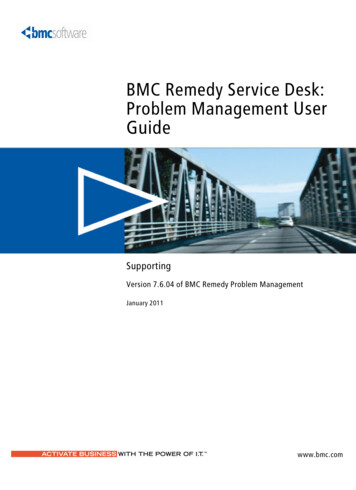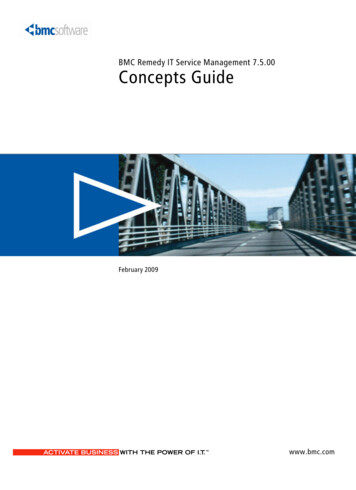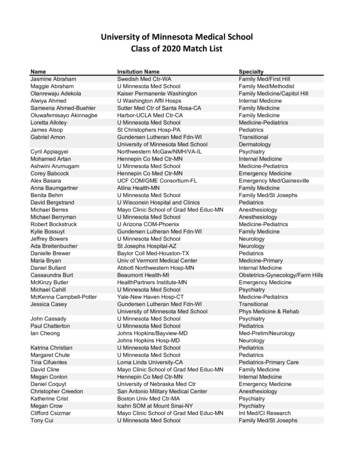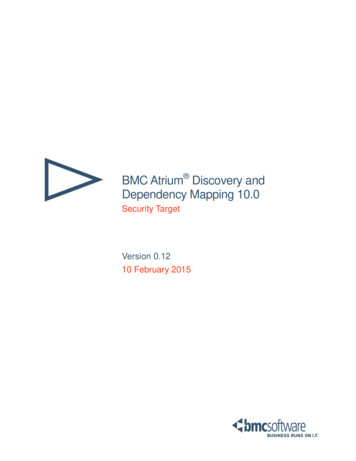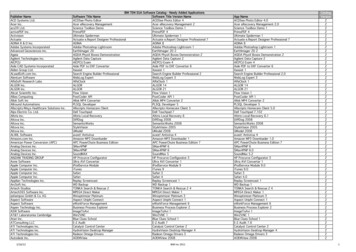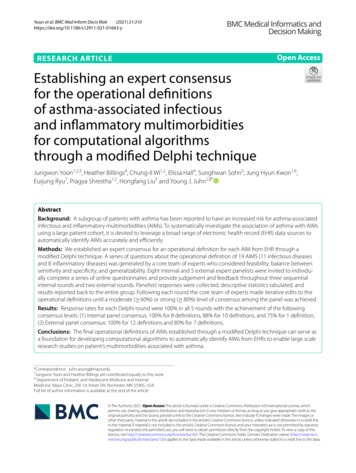
Transcription
(2021) 21:310Yoon et al. BMC Med Inform Decis RCH ARTICLEOpen AccessEstablishing an expert consensusfor the operational definitionsof asthma‑associated infectiousand inflammatory multimorbiditiesfor computational algorithmsthrough a modified Delphi techniqueJungwon Yoon1,2,3, Heather Billings4, Chung‑Il Wi1,2, Elissa Hall4, Sunghwan Sohn5, Jung Hyun Kwon1,6,Euijung Ryu7, Pragya Shrestha1,2, Hongfang Liu5 and Young J. Juhn2,8*AbstractBackground: A subgroup of patients with asthma has been reported to have an increased risk for asthma-associatedinfectious and inflammatory multimorbidities (AIMs). To systematically investigate the association of asthma with AIMsusing a large patient cohort, it is desired to leverage a broad range of electronic health record (EHR) data sources toautomatically identify AIMs accurately and efficiently.Methods: We established an expert consensus for an operational definition for each AIM from EHR through amodified Delphi technique. A series of questions about the operational definition of 19 AIMS (11 infectious diseasesand 8 inflammatory diseases) was generated by a core team of experts who considered feasibility, balance betweensensitivity and specificity, and generalizability. Eight internal and 5 external expert panelists were invited to individu‑ally complete a series of online questionnaires and provide judgement and feedback throughout three sequentialinternal rounds and two external rounds. Panelists’ responses were collected, descriptive statistics tabulated, andresults reported back to the entire group. Following each round the core team of experts made iterative edits to theoperational definitions until a moderate ( 60%) or strong ( 80%) level of consensus among the panel was achieved.Results: Response rates for each Delphi round were 100% in all 5 rounds with the achievement of the followingconsensus levels: (1) Internal panel consensus: 100% for 8 definitions, 88% for 10 definitions, and 75% for 1 definition,(2) External panel consensus: 100% for 12 definitions and 80% for 7 definitions.Conclusions: The final operational definitions of AIMs established through a modified Delphi technique can serve asa foundation for developing computational algorithms to automatically identify AIMs from EHRs to enable large scaleresearch studies on patient’s multimorbidities associated with asthma.*Correspondence: Juhn.young@mayo.edu†Jungwon Yoon and Heather Billings are contributed equally to this work.8Department of Pediatric and Adolescent Medicine and InternalMedicine, Mayo Clinic, 200 1st Street SW, Rochester, MN 55905, USAFull list of author information is available at the end of the article The Author(s) 2021. Open Access This article is licensed under a Creative Commons Attribution 4.0 International License, whichpermits use, sharing, adaptation, distribution and reproduction in any medium or format, as long as you give appropriate credit to theoriginal author(s) and the source, provide a link to the Creative Commons licence, and indicate if changes were made. The images orother third party material in this article are included in the article’s Creative Commons licence, unless indicated otherwise in a credit lineto the material. If material is not included in the article’s Creative Commons licence and your intended use is not permitted by statutoryregulation or exceeds the permitted use, you will need to obtain permission directly from the copyright holder. To view a copy of thislicence, visit http:// creat iveco mmons. org/ licen ses/ by/4. 0/. The Creative Commons Public Domain Dedication waiver (http:// creat iveco mmons. org/ publi cdoma in/ zero/1. 0/) applies to the data made available in this article, unless otherwise stated in a credit line to the data.
Yoon et al. BMC Med Inform Decis Mak(2021) 21:310Page 2 of 11Keywords: Delphi, Asthma, Multimorbidities, Electronic health records, Natural language processingBackgroundAsthma is the most common chronic illness of childhood, representing one of the five most burdensomechronic diseases in US adults [1–3]. Our group andothers demonstrated asthma’s impact on the risks of abroad range of infectious and inflammatory diseases,namely asthma-associated infectious and inflammatory multimorbidities (AIMs) as an under-recognizedhealth threat to adults and children with asthma [4–26]. The Centers for Disease Control and Preventionterms asthma as an independent risk factor for invasivepneumococcal diseases. At present, the 2008 US and2014 Canadian pneumococcal vaccine policies recommend a single dose of 23-valent pneumococcal polysaccharide vaccine (PPV-23) to adults with asthma ages19–64 years [27–29]. A recent prospective cohort studyshowed that asthma’s impact on the risk of any infection as measured by a population attributable risk percent was similar to that of diabetes mellitus(DM) (2.2%vs. 2.9%, respectively) [8]. Impairment of both innateand adaptive immunity is the currently proposed mechanism for this association [9]. To mitigate the risks andoutcomes of AIMs through clinical care and research,it is necessary to develop innovative strategies enablingidentification and characterization of a subgroup ofasthmatic children at risk of AIMs at a population level,especially studies requiring precision such as mechanism studies.For example, to study the nature of the association ofasthma with the risk of pneumonia, one must identifypneumonia by more than the inherently limited International Statistical Classification of Diseases (ICD) codes.The additional use of practical, predetermined criteriaderived from guidelines and expert panels leveraging abroad range of EHR data sources is crucial for accurateand efficient identification in EHR-based studies. Thisincludes the free text in a physician diagnosis, key termsreferring to pneumonia in chest x-rays, and clinical notes.This type of manual chart review can be done for smallerstudies, but becomes burdensome when applied to large,population-based studies with the goal of investigatingnumerous AIMs. Our group has developed and appliedmultiple computational algorithms (eg, natural languageprocessing [NLP] algorithms) to automate the chartreview process in regards to the two existing asthmacriteria, asthma prognosis, and other asthma outcomes[30–33]. Those algorithms fully leverage EHRs in a waythat effectively and efficiently phenotypes asthma, making asthma care and research scalable [30–32]. On theother hand, despite the significance of AIMs as a majorhealth threat to people with asthma, computational algorithms for identifying AIMs are largely unavailable due tothe lack of operational definitions which are critical fordeveloping computational algorithms to automate thechart review process.Deriving operational definitions based on the consensus of expert panels facilitates transparency and interpretability of downstream computational algorithms.Computational algorithms for a broad range of healthconditions developed by different institutions using different approaches are available through eMERGE [34]and PheKB [35, 36]. However, very few studies report thedevelopment process of a rigorous operational definitionfor computational algorithms that can be reused systematically in a new area [37].Herein we demonstrate the process and the results ofestablishing an operational definition for each AIM forthe pediatric population through consensus buildingamong internal and external experts using a modifiedDelphi method. The Delphi method relies on a groupof experts to provide sequential levels of anonymousresponses and feedback through a series of questionnaires to reduce range of responses and arrive at a predetermined level of consensus. This consensus buildingmethod is becoming a popular means through which togenerate operational definitions and practice guidelines,as evident through recent work published in the fields ofOtolaryngology, Pediatric Critical Care, and Geriatrics toname but a few [38–42].MethodsThe Delphi method has a myriad of applications and isoften used in health services research, providing controlled feedback and systematic progression towardconsensus among a panel of experts during completionof a series of voting rounds [43–46]. A modified processeliminates the initial open-ended questionnaire phase inlieu of a pre-population of statements that are reviewedand voted on by a panel of experts [47–49]. This modified Delphi method for consensus building serves as themethodological framework for researchers to developand apply computational algorithms for AIMs.ParticipantsA core team of five clinicians and scientists draftedthe initial set of operational definitions. The internalexpert panel consisted of eight physicians from a single institution practicing in the fields of Rheumatology
Yoon et al. BMC Med Inform Decis Mak(2021) 21:310Page 3 of 11(TM, AO), Infectious Disease (CH, ER), Gastroenterology (IA, MG) and Allergy (MP, AR). The five-memberexternal panel of experts consisted of physicians practicing in the fields of Family Medicine/Epidemiology,Infectious Disease, Rheumatology, Pediatric CriticalCare, and Gastroenterology all within the United States(see the Acknowledgement section). Criteria for panelinclusion included national recognition as an expert asevidenced through multiple peer reviewed publicationsin their field, presentations at national conferences, andleadership roles in professional societies. Participantswere informed that participation in the project wouldrequire them to complete multiple Delphi roundsduring which they would complete an online questionnaire, which would take 5–7 min. See Table 1 fordetailed demographics of panel members.Questionnaire developmentIn order to posit the list of 19 potential AIMs and theiroperational definitions, the core team conducted (1)literature reviews per AIM and (2) a manual review ofall ICD-9/10 codes for 24,003 electronic health recordsof children who were born in Olmsted County, Minnesota, between 1997 and 2016. These definitions werecategorized within infectious disease conditions (11)and inflammatory disease conditions (8) (Fig. 1).The definitions were composed via an online questionnaire distributed through email and administeredTable 1 Participants’ demographic demic rankingProfessor5Associate Professor2Assistant Professor5Instructor1Medical doctor specialtyRheumatology3Infectious Disease3Gastroenterology3Allergy2Family medicine/epidemiology1Pediatric critical care1Number of years post-residency training0–415–106 106using Qualtrics software (version 2017, Provo, UT).Each operational definition included one or more proposed criteria statements linked by a conjunction suchas “and”, or “or”. Respondents were asked to respondYes or No to the prompt “Do you agree with this?” foreach of the operational definitions (Fig. 2). Respondents were instructed to keep the following questions inmind:1. Is the operational definition of sufficient clinicalvalue to warrant inclusion?2. Is the wording of the operational definition clear andprecise to avoid misinterpretation?If the response was No, respondents were promptedto suggest specific changes in the subsequent free textspace. All responses and comments were reviewed, andedits were incorporated into the next iteration of definitions. Figure 2 shows an example of the survey process.Moderate consensus was defined as 60–79% agreementamong respondents, and strong consensus was definedas 80% agreement among respondents for each AIM.Internal expert panel (IEP) voting roundsThe IEP members were given 7 days to complete theonline questionnaire. Three follow-up emails were sentto non-respondents on the 3rd, 4th and 7th day whichresulted in completion of the survey by all 8 IEP members. Core team members reviewed all response dataand drafted modified operational definitions as necessary. These modified definitions were then resubmittedfor review through an online questionnaire during thenext Delphi round until consensus ( 60%) was achieved.Rounds two and three followed an identical processincluding the 3 subsequent reminders.External expert panel (EEP) voting roundsA five-member External Expert Panel (EEP) was enlistedto confirm consensus of the 19 operational definitions,which had achieved moderate or greater consensusamong the IEP members. Two Delphi voting rounds wereconducted following the same process as with the IEPuntil 60% agreement. Additional file 1: Fig. 1 shows thequestionnaire used at the 2nd round for EEP.This project was approved by the Mayo Clinic Institutional Review Board (#14-009934).ResultsDefinitions of AIMs and response rateIn this study, 19 operational definitions were generated bya core team and then updated based on three sequentialrounds with 8 IEP members, and two rounds with 5 EEP
Yoon et al. BMC Med Inform Decis Mak(2021) 21:310Page 4 of 11Fig. 1 Overall process for identifying 19 AIMs and their operational definitionsmembers from various institutions (Table 2). Responserate from participants was 100% for each round.Percentage agreement rate for each AIMPercentage agreement rate for each definition of AIMs issummarized in Table 3.Consensus levels achieved are as follows: (1) Internal panel consensus: 100% for 8 definitions, 88% for 10definitions, and 75% for 1 definition, (2) External panelconsensus: 100% for 12 definitions and 80% for 7 definitions. In total, 18 of 19 definitions achieved strong consensus ( 80%) in both internal and external rounds. The
Yoon et al. BMC Med Inform Decis Mak(2021) 21:310Page 5 of 11Round 1 – Online questionnairePhysician diagnosis of pneumonia documented with antibiotic therapy ANDChest radiograph finding suggesting pneumonia (consolidation, lobar pneumonia, and infiltrates)Do you agree? (n 8)7 internal expert panels(IEP) agree1 IEP members disagree and suggest the following edits1. "Infiltrates" may be too imprecise a term. Suggest "alveolar infiltrates".1.2.Core team reviews responses and because most radiology reports at Mayo Clinic do not use“alveolar infiltrates” but “infiltrates”, core team propose to keep the current definition.Results and feedback are shared with IEP through subsequent Delphi roundsRound 2 – Online questionnairePhysician diagnosis of pneumonia documented with antibiotic therapy ANDChest radiograph finding suggesting pneumonia (consolidation, lobar pneumonia, and infiltrates)Do you agree? (n 8)5 internal expert panels(IEP) agree3 IEP members disagree and suggest the following edits1. Instead of and imaging maybe and/or compatible exam findings2. Current PIDS/IDSA guidelines do not require a CXR for outpatient CAP--exam findings can besufficient. Suggest : physician diagnosis AND CXR OR exam findings (crepitations).Consider whether wheezing should be excluded.3. Not sure the "with antibiotic therapy" is needed1.2.Core team reviews responses and makes edits to operational definition.Results and feedback are shared with IEP through subsequent Delphi roundsRound 3 – Online questionnaireUpdated operational definition of pneumonia:Physician diagnosis of pneumonia documented ANDCompatible exam findings (fever 100.5 F AND cough AND rale or crackle or crepitation) AND/ORChest radiograph finding suggesting pneumonia (consolidation, lobar pneumonia, and infiltrates)Do you agree? (n 8)8 internal expert panels(IEP) agreeTwo rounds with the external expert panel were done in the same process as above.Final agreement rate of pneumonia in external rounds was 80%.Fig. 2 Example of Delphi process and iterative submission of operational definitions for AIMs (e.g., Pneumonia). Three internal and two externalrounds were completed sequentiallysingle definition that did not reach strong consensus wasregarding Kawasaki disease (KD) which achieved a consensus rating of 75% by the final internal round. Insightinto this lower consensus comes from the commentsof the 2 panelists who didn’t agree with the definition.The comments are as follows: “How will you handle a
Yoon et al. BMC Med Inform Decis Mak(2021) 21:310Page 6 of 11Table 2 Final operational definition of 19 asthma-associated infectious and inflammatory comorbiditiesInfectious diseasesEHR sources1. Invasive Bacterial Infection: A AND BLab result, Clinical note (Diagnosis)A: Any pathogenic bacteria isolated from normally sterile body fluid includ‑ing blood, CSF, pleural fluid, pericardia fluid, peritoneal fluid, or synovial fluid,B. Any physician diagnosis of sepsis, bacteremia, meningitis, encephalitis,mastoiditis, brain abscess, pneumonia, cellulitis, osteomyelitis, septic arthritis,pleuritis, or pericarditis, and pyelonephritis documented in medical recordsrelated to bacteria source cultured2. Frequent Streptococcus Pyogenes Upper Respiratory Infection: A AND B AND CA. Physician diagnosis of sore throat, pharyngitis and tonsillitisB. Throat swab test (rapid antigen detection test (RADT), Streptococcuspyogenes culture, or PCR [Polymerase chain reaction])C. 3 or more episodes within 12 monthsLab result, Clinical note (Diagnosis)3. Pneumonia: A AND (B AND/OR C)A. Physician diagnosis of pneumoniaB. Compatible exam findings (fever 100.5 F AND cough AND rale orcrackle or crepitation)C. Chest radiograph finding suggesting pneumonia (consolidation, lobarpneumonia, and infiltrates)Clinical note (Diagnosis, History of present illness, Physical examination),Chest X-ray finding4. Recurrent or Persistent Otitis MediaCPT (Current Procedural Terminology) codes for tympanostomy tube place‑ment (surrogate marker for either persistent or recurrent otitis media duringchildhood)CPT codes5. Recurrent or Persistent Infectious Sinusitis: A AND (B AND/OR C)A. 4 or more episodes of Physician diagnosis of sinusitis documented withantibiotic prescription over 12 monthsB. Sinus CT findings suggestive of sinus opacification or air/fluid levelC. Sinus surgeryClinical note (Diagnosis), Computerized Tomography (CT) finding,Operational note6. Bordetella PertussisPolymerase Chain Reaction (PCR) for Bordetella pertussis from the upperrespiratory tractLab result7. Breakthrough Varicella Infection: A AND/OR BA. Physician diagnosis of Varicella (chickenpox)B. Positive lab result (PCR ) of varicella infection occurred 42 days aftervaricella vaccination (excluding non-vaccinated children)Lab result, Clinical note (Diagnosis)8. Zoster (Shingles): A AND (B AND/OR C)A. Physician diagnosis of zosterB. Positive lab result (PCR )C. Anti-viral medication for Varicella zoster virus (e.g. acyclovir)Lab result, Clinical note, Medication prescription9. Urinary Tract Infection (UTI): Urinary test results supporting the evidence of UTIas follows; A AND BA. Recovery of any organisms from a suprapubic specimen, at least 50 000colony-forming units per milliliter (CFUs/mL) from a catheterized specimen,or at least 100 000 CFUs/mL from a clean-catch specimenB. At least 10 white blood cells per microliter from an unspun specimenexamined using a counting chamber or at least 5 white blood cells per highpower field from a centrifuged specimenLab result10. Skin Fungal Infection: A AND/OR BA. Physician diagnosis of any skin fungal infection with antifungal therapyB. Fungal culture or fungal smear positiveLab result, Clinical note (Diagnosis)11. Clinically Significant Viral Infection confirmed by lab: A AND BA. A physician diagnosis of respiratory or gastrointestinal viral infectionB. PCR or culture test for respiratory or gastrointestinal virus infectionLab result, Clinical note (Diagnosis)12. Celiac Disease (CD): A AND ([B AND C] AND/OR [D AND E])A. Physician diagnosis of Celiac disease documented at least once by gastro‑enterologistB. Positive CD serology markers (TTG lgA 10 higher than normal)C. EMA positivity or DGA positivelyD. TTG IgA positivityE. Histologic findings (increased in IEL, villous atrophy, crypts hyperplasia)Lab result, Clinical note (Diagnosis), Endoscopy findingInflammatory diseases
Yoon et al. BMC Med Inform Decis Mak(2021) 21:310Page 7 of 11Table 2 (continued)Infectious diseasesEHR sources13. Kawasaki DiseasePhysician diagnosis of Kawasaki disease documented at least once by infec‑tious disease, cardiology, or rheumatology specialistClinical note (Diagnosis)14. Appendicitis: A OR (B AND C)A. Surgeon’s diagnosis in operation note (excluding incidental appendec‑tomy or normal appendix)B. Physician diagnosis of appendicitisC. Imaging study suggestive of appendicitisClinical note (Diagnosis), Operational note, CT or Ultrasound finding15. Autoimmune ThyroiditisClinical note (Diagnosis)Physician diagnosis of autoimmune thyroiditis documented at least twice ina 6 month or greater span including endocrinologist’s diagnosis at least once16. Diabetes Type 1Physician diagnosis of Type 1 Diabetes documented at least twice in a6 month or greater span including endocrinologist’s diagnosis at least onceClinical note (Diagnosis)17. Diabetes Type 2Physician diagnosis of Type 2 Diabetes documented at least twice in a6 month or greater span including endocrinologist’s diagnosis at least onceClinical note (Diagnosis)18. Inflammatory Bowel Disease (IBD; Crohn’s Disease (CD), Ulcerative Colitis (UC)) Clinical note(Diagnosis)Physician diagnosis of IBD, CD, or UC documented at least twice in a 6 monthor greater span including gastroenterologist’s diagnosis at least once19. Juvenile Rheumatoid Arthritis (JRA), Juvenile idiopathic Arthritis (JIA), orClinical note (Diagnosis)Rheumatoid Arthritis (RA)Physician diagnosis of JRA, JIA, and RA documented at least twice in a6 month or greater span including a rheumatologist’s diagnosis at least onceTable 3 The consensus level attained for each of the 19 operational definitions of asthma associated infectious and inflammatorymultimorbidities (AIMs)Total mean (SD)% ofagreement (n 13)Final % of IEP that agreed withthe definition (n 8)Final % of EEP that agreedwith the definition (n 5)Invasive bacterial infection91 (9)88100Frequent Streptococcus pyogenes upper res‑piratory infection87 (8)8880Pneumonia82 (14)10080Recurrent/persistent otitis media87 (19)100100100Recurrent/persistent infectious sinusitis80 (17)88Bordetella pertussis98 (6)100100Breakthrough varicella infection94 (9)88100Zoster (Shingles)86 (17)10080Urinary Tract Infection89 (7)88100Skin Fungal Infection85 (10)10080Viral Infection confirmed by lab85 (21)100100Celiac disease83 (24)100100Kawasaki disease84 (11)7580Appendicitis98 (6)88100Autoimmune thyroiditis82 (25)8880Diabetes type 190 (17)88100100Diabetes type 290 (17)88Inflammatory bowel disease77 (18)10080JRA, JA, RA84 (16)100100JRA, Juvenile Rheumatoid Arthritis; JA, Juvenile idiopathic Arthritis; RA, Rheumatoid Arthritis
Yoon et al. BMC Med Inform Decis Mak(2021) 21:310“possible” or “rule out” diagnosis? I think the IVIG (Intravenous immunoglobulin) treatment requirement is helpful” and “I agree with the definition, but I am not sure ifthis happens in practice (e.g. I don’t believe specialistsare always consulted in the inpatient setting)”. Treatmentcondition (e.g. IVIG) was initially included in the definition but, the panel proposed to take it out and the coreteam of experts accepted and updated the definition afterthe second internal round. Thus, 7 out of 8 panels actually agreed with the definition, but one panelist selected“No” solely due to the electronic format (the panelist hada comment to offer and could only have access to a texting box if they selected “No”.Feedback from the panels and process of modificationsThe reasons for the disagreement from expert panelistswere summarized as follows: (1) requiring more confirmative methods (53%)—e.g. specialist diagnosis andlaboratory findings, (2) definition is too narrow (22%),(3) wording of the operational definition needs clarification (19%), (4) clarifying the condition of “period” bystating a definitive span of time, in the cases of recurrentor chronic disease (4%), and (5) others—e.g. editorialerror. The core team reviewed the suggestions made bythe internal and/or external panelists with considerationgiven to the following points: (1) existing literature on theoperational definition of each AIM, (2) balance betweensensitivity and specificity of each condition, (3) generalizability when used at other institutions, and (4) feasibilityof development of computational algorithm.DiscussionResponse rates for each Delphi round were 100% in all 5rounds. Using a modified Delphi technique, we achievedstrong consensus ( 80%) for operational definitions of allAIMs except one (75% at the final internal round), whichcan be applicable to computational algorithms. Overall,this process adds accuracy and reliability to studies concerning the association between asthma and AIMs.At the end of three sequential rounds, 7 to 8 of the eightinternal panelists (depending on the specific AIM beingevaluated) reached agreement on the final operationaldefinition of each AIM resulting in an 88–100% consensus. For example, at the end of the first round, 4 AIMs hadachieved a consensus of less than 70%, but through thereiteration process (e.g. feedback and modification), wereached a moderate to strong consensus ( 75%) for allAIMs. Upon sending the updated definitions to externalpanelists, 5 AIMs still had a consensus of less than 70%at the end of the second and final round, including recurrent otitis media, recurrent infections sinusitis, autoimmune thyroiditis, diabetes type 1 and 2. Of these 5, wemodified the definitions of three inflammatory diseasesPage 8 of 11to make them more specific, but proposed to keep thedefinition of the two infectious diseases by making further clarifications. As a result, 4 to 5 out of 5 panelists(80–100%) reached agreement on the final definitions ofeach AIM. Given their different specialties and practicesettings, the feedback from the group of external expertswas very helpful for ascertaining the generalizability ofthese operationalized definitions in other study settings.This novel study is the first to use a modified Delphimethod to construct operational definitions for eachAIM enabling us to develop computational algorithms toidentify AIMs from EHRs. After considering literature,feasibility (data accessibility, specificity (for mechanismstudy), and generalizability (for implementing to otherinstitutions), the balance between specificity and sensitivity of each definition was decided by the core team inresponse to panel feedback with updating of definitionsas deemed reasonable.The main concern of the panelists was the need forother diagnostic methods in the operational definition.For example, the operational definitions of six inflammatory diseases including Kawasaki disease, autoimmune thyroiditis, diabetes type 1 and 2, inflammatorybowel disease, and the arthritis group (Juvenile Rheumatoid Arthritis, Juvenile idiopathic Arthritis, or Rheumatoid Arthritis) were defined only by physician diagnosisincluding a specialist’s diagnosis at least once. In the initial operational definition, more than two diagnoses by aphysician were included, but in accordance with feedbackfrom the panelists, this definition was modified. It nowreads as requiring the diagnosis of specialist at least onceand this is deemed reasonable for confirmation as thesediseases are generally confirmed by specialists who seethe patient after referral from a primary care physician orclinician at another medical institution. Furthermore, theprecision of some of the AIMs was improved via the panelist’s suggestions of adding a laboratory test or treatmentcondition (e.g. urinary tract infection (UTI)). For example, historically, a varicella diagnosis was made clinically.Due to the varicella vaccine, varicella symptoms becomemilder with fewer lesions. In turn, this has caused clinicians to become more conservative in making a diagnosis of varicella. Currently, evaluation and managementof varicella cases in outpatient settings is still primarilybased on clinical ground. Unless there is a public healthconcern viral testing is infrequently ordered. Thus, weproposed the operational definition as, physician diagnosis of varicella AND/OR positive laboratory test. Havingsaid that, our group has a project that focuses on understanding the immune mechanisms of AIMs as it relatesto asthma, and therefore we took a generally conservative stance of keeping the definition even as it increasesspecificity at the cost of potentially reducing sensitivity.
Yoon et al. BMC Med Inform Decis Mak(2021) 21:310Depending on the scope of the study, other investigators can revise these definitions for each AIM, tailoringit to their particular study (e.g. balancing sensitivity vs.specificity).For some AIMs, the core team initially proposed usingonly structured data, which was agreed upon by panelists,such as tympanostomy placement as a surrogate markerfor recurrent or persistent otitis media. Since a child canhave persistent or recurrent otitis media without havingtympanostomy, the proposed definition can only identify those children who had tympanostomy tubes placed,which may increase specificity, but lower sensitivity.However, since clinicians utilize various diagnostic termswhen referring to recurrent or persistent ear infections,it is challenging to identify children with true recurrentor persistent ear infections, especially using a computerprogram like natural language processing (NLP) algorithm. A previous study addressed this problem by usingCurrent Procedural Terminology (CPT) codes for tympanostomy tube placement to identify children with recurrent or persistent ear infections [50]. As ear infectionsare a common childhood malady and diagnosis/identification of ear infections in medical records are variable,we chose to be conservative in identifying recurrent orpersistent ear infections. At any rate, it is worth notingthat differential data sources and fragmentation markedlyimpact the performance of computational phe
Medicine, Mayo Clinic, 200 1st Street SW, Rochester, MN 55905, USA . broad range of infectious and inammatory diseases, namely asthma-associated infectious and inamma-tory multimorbidities . is project was approved by the Mayo Clinic Institu-t



